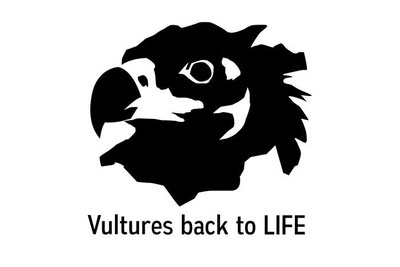
Vultures need all the help they can get when it comes to changing their bad reputation and shedding light to the conservation that they need! On this blog post, we will take a closer look on Europe’s vultures, discussing key facts and our conservation initiatives.
Egyptian Vulture

The Egyptian Vulture is Europe’s smallest vulture and weighs around 2kg. It’s the world’s only tool-using vulture and Europe’s only long-distance migratory vulture.
Egyptian Vultures in Europe
In 2007, the species was declared globally ‘Endangered’ by the International Union for the Conservation of Nature’s Red List. In Europe, the population of Egyptian Vultures has declined by a staggering 50 per cent in the last 40 years. The majority of the European population is found on the Iberian peninsula with an estimated 1,300 – 1,500 pairs, the remaining populations being in France (80 pairs) and Italy (10 pairs).
Did you know
The Egyptian Vulture carries out a 7,000km migratory round trip, spending its winters in Sub-Saharan Africa and returning from March to reproduce in Europe. Along the eastern Mediterranean flyway, it faces many threats, from electrocution to poisoning. Dr Steffen Oppel will discuss major threats and the demographic changes that are needed to stabilise the Egyptian Vulture population on the Balkans during the European Vulture Conference.
Conservation

Out of the four species of vultures in Europe, they are the one that is still in decline. Our LIFE Rupis conservation project, led by SPEA, is working in the cross-border Douro region of Spain and Portugal to protect and strengthen the populations of Egyptian Vultures and Bonelli’s eagles. The project is creating a network of feeding stations, improving habitat and nesting sites as well as tackling the significant threats of electrocution and illegal wildlife poisoning.

Bearded Vulture

This vulture has a unique eating habit – its diet consists of 80 to 90% of bleached carcass bones. Bearded Vultures in the wild rub themselves with ferric oxides, which turns the colour of their plumage to rusty orange. Captive-born birds are therefore not rusty but white.
Bearded Vultures in Europe
Due to changes in farming practices and direct persecution, the population of the species crashed by the beginning of the 20th Century and disappeared throughout most of its former range. Today it’s Europe’s rarest vulture and flies only in the Alps, in the Pyrenees, in Andalusia, and isolated populations in Crete and Corsica.
Did you know
Wrongly accused of killing sheep, the species was hunted to extinction in the Alps, with the last Bearded Vulture shot at Aosta Valley Italy in 1913. But in 1986, a reintroduction programme was launched that managed to bring the species back to the Alpine region, making one of the best wildlife comeback stories of all time! Since the start, their population has been intensively monitored using different techniques. Our Scientific and conservation coordinator will take us through their comeback, and how monitoring is vital for their conservation during the European Vulture Conference.
Conservation

One of our vulture conservation projects, LIFE GYPCONNECT, led by LPO, aims to connect the populations in the Alps and the Pyrenees, helping to restore the species’ former range by releasing captive-bred Bearded Vultures into the wild. To facilitate movements between the new population and the Alpine and Pyrenean populations, the LIFE GYPCONNECT team is creating a network of supplementary feeding stations, and tackling threats such as poisoning, and collision and electrocution with electricity infrastructure.
Griffon Vulture

With their characteristic long slender necks, Griffon Vultures can reach far into the carcasses of animals, to feed on the softer tissues such as muscles and viscera. These majestic birds are the most social of Europe’s four vulture species. They feed in groups and roost and breed in large colonies.
Griffon vultures in Europe
Following a decline in the 20th Century as a result of wildlife poisoning, hunting and decreasing of food supplies, in recent years the species has increased dramatically in some areas, particularly in Spain, France and Portugal, with the population in Europe now exceeding 35,000 breeding pairs.
Did you know
The morphology of Griffon Vultures constrains them to use a soaring-gliding flight, depending on local atmospheric conditions, therefore, they face many challenges while foraging. Dr Olivier Duriez, one of our keynote speakers at the European Vulture Conference, will discuss how they cope.
Conservation

Populations of vultures drastically decreased in the Balkans over the 20th Century. Our LIFE Re-Vultures project, led by Rewilding Europe, aims to support the recovery and expansion of the region’s only Cinereous Vulture colony and Bulgaria’s last population of Griffon Vultures in the Rhodope Mountains that border Greece and Bulgaria. The project is improving natural prey availability, monitoring movements of birds to help understand the threats they face and carrying out activities that will reduce the mortality of the populations from threats such as illegal wildlife poisoning and collisions with electricity infrastructure.

Cinereous Vulture

The Cinereous Vulture is one of the heaviest and largest raptors in the world, with its wingspan almost reaching 3 metres.
Cinereous Vultures in Europe
Over the 20th Century, the population of the species has decreased across its distribution area in Europe. In many European countries (for example in Italy, Austria, Poland, Slovakia and Romania), the species is now extinct. Today the species is recovering fast in Spain, recolonised Portugal and were reintroduced in France. In the east of the species’ former range, there is only a small isolated population in Dadia forest (Greece).
Did you know
We recently saved a Cinereous Vulture from a wind turbine collision! All together for vultures, we tracked Carrascalinho and collaborated with local partners and authorities in Spain and managed to switch off turbines to prevent a possible collision.
Conservation

They were declared extinct in Bulgaria in the 1980s, but our Vultures Back to LIFE project, led by the Green Balkans, aims to reintroduce the species back to the country. The team will transfer and release around 60 birds, some from captive-breeding, but mostly coming from wildlife rehabilitation centers in Extremadura (Spain) into the wild in Bulgaria as well as creating supplementary feeding stations and improving populations of wild herbivores, improving the nesting conditions and creating artificial nest sites and tackling some of the major threats to vultures in the country, such as insulating electricity pylons and illegal use of poison in nature.

Europe’s 5th vulture species?

Andalusia has added Rüpell’s Vulture to their list of vultures! So it is becoming official – Europe has now a 5th vulture species and one that is globally Critically Endangered. Even though there are no definite breeding records of this species in Europe yet, the vulture frequently visits the region.
Why are vultures important?
Even thought many people perceive vultures as lowly scavengers, they play a crucial role in the environments in which they live. Vultures are a distinctive, unique and spectacular component of the earth’s biodiversity. They provide critically important ecosystem services by cleaning up after death, acting as natural carcass recyclers and providing great socioeconomic value to local communities.
International Vulture Awareness Day

On the first Saturday in September each year the International Union for the Conservation of Nature (IUCN) Vulture Specialist Group, the UK’s Hawk Conservancy Trust and South Africa’s Endangered Wildlife Trust co-ordinate the International Vulture Awareness Day.
Share our posts and help us spread awareness about vultures!






